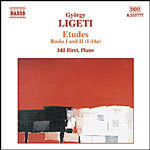
Etudes for Piano Books I & II
 $25.00
Out of Stock
$25.00
Out of Stock6+ weeks add to cart
LIGETI
Etudes for Piano Books I & II
Idil Biret (piano)
[ Naxos / CD ]
Release Date: Tuesday 20 May 2003
This item is currently out of stock. It may take 6 or more weeks to obtain from when you place your order as this is a specialist product.
Idil Biret's interpretations have altogether greater expressive immediacy, not least in the enfolding rhythmic contours of 'Cordes a vide', the ominous momentum sustained in 'Automne a Varsovie', and the gamelan evocations of 'Galamb borong'."
- Richard Whitehouse, Gramophone, April 2003
As György Ligeti himself describes it, the impetus for "... composing highly virtuosic piano études ... was, above all, my own inadequate piano technique". Solo piano music is prominent in his output prior to his 'escape' to the West in 1956, notably the Musica ricercata cycle completed in 1953, but little emerged during his involvement with the European avant-garde over the next two decades. At the end of the 1970s and the beginning of the 1980s, Ligeti rethought all aspects of his composing idiom, resulting in music which might be described as 'post-tonal' in its creative and unprejudiced approach to the 'Classical' tradition. Among the first fruits of this reassessment was Book I of the piano Etudes, comprising six pieces and completed in 1985. A second book of eight pieces was composed between 1988 and 1994, while a third book was started in 1995.
Numerous influences are at work on these Etudes. The étude cycles of Chopin and Debussy, each vital to the evolution of the piano and its literature, are an inevitable presence, as are the keyboard techniques of Scarlatti and Schumann. Yet the rôle of sub-Saharan African culture is crucial in the often complex rhythmic polyphony that motivates Ligeti's Etudes; indeed, polyrhythms and shifting pulses are essential to the sound and feel of the music at all times. Geometric patterns, especially the self-repetition of 'fractals', were a vital stimulus, as were the rhythmic and metric innovations of the maverick American composer Conlon Nancarrow (1912-1997) and the pianism of such jazz 'greats' as Thelonious Monk and Bill Evans. Yet there is no sense of eclecticism in the music itself: to quote the composer again, "... it is neither 'avant-garde' nor 'traditional', neither tonal nor atonal. ... These are ... études in the pianistic and compositional sense. They proceed from a very simple core idea, and lead from simplicity to great complexity: they behave like growing organisms".
Tracks:
Book I
01. I - Desordre 2:51
02. II - Cordes a vide 4:36
03. III - Touches bloquees 2:34
04. IV - Fanfares 4:08
05. V - Arc-en-ciel 3:38
06. VI - Automne a Varsovie 5:39
Book II
07. VII - Galamb Borong 3:24
08. VIII - Fem 3:40
09. IX - Vertige 3:55
10. X - Der Zauberlehrling 2:12
11. XI - En suspens 2:48
12. XII - Entrelacs 3:15
13. XII - L'escalier du diable 6:51
14. XIV - Coloana infinita 2:00
15. XIVa - Coloana fara sfarsit 2:11

